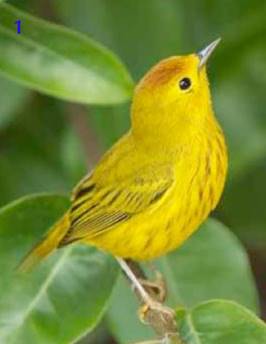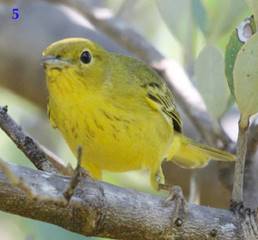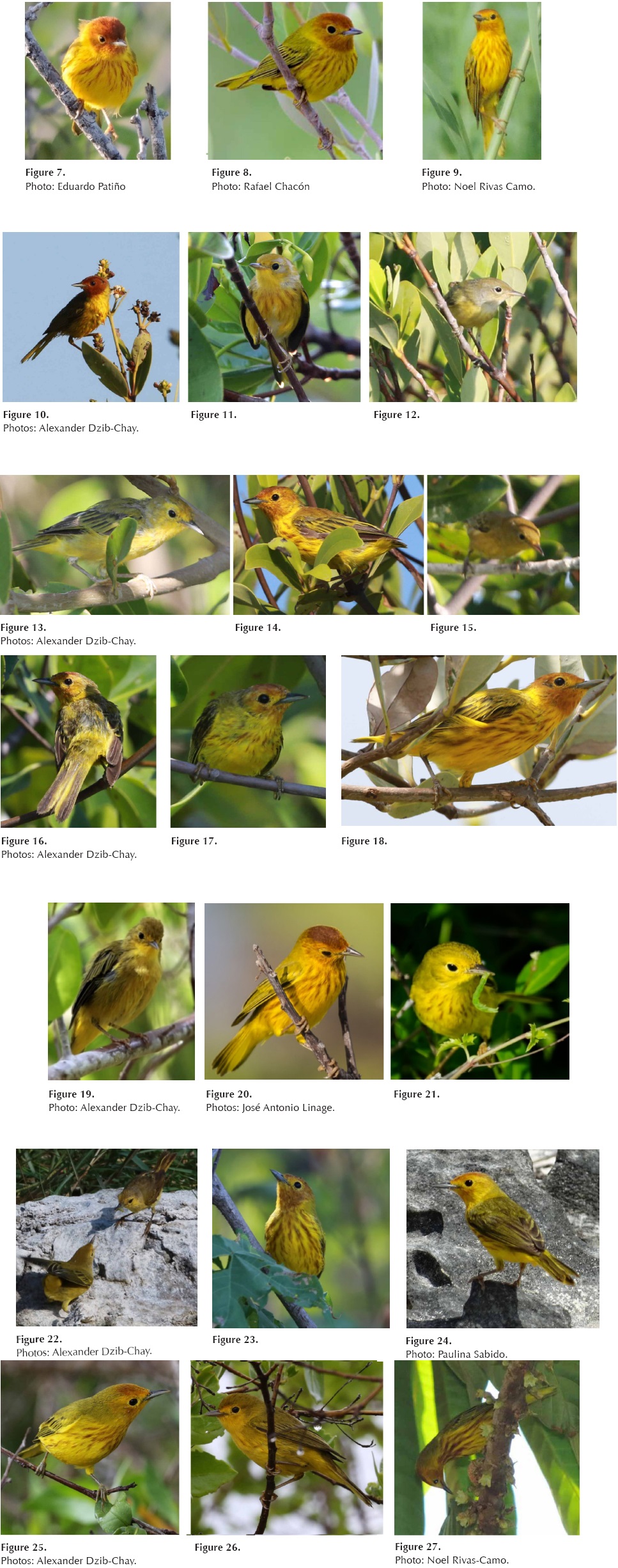Editora asociada: Sophie Calmé
Introduction
The objective of this paper is to describe a new population of Yellow Warbler (Setophaga petechia) that we discovered serendipitously on Cozumel. We concentrated on photographing plumages of different ages and sexes, and exploring areas of mangrove wetlands in order to understand the distribution of the bird on the island in relation to habitat type. Cozumel Island is known to have the endemic Golden Warbler (Setophaga petechial rufivertex) (Figures 1 and 2), one of 43 subspecies of the Yellow Warbler (Browning 1994, Dunn and Garrett 1997, Salgado-Ortiz et al. 2008). Dr. Raymond Paynter, Jr. described the habitat of this bird as follows: “Bushes and small trees throughout the island” (Paynter 1955), while Griscom stated: “Dendroica ruficapilla (=Setophaga petetchia) rufivertex Ridgway - This species of obvious Antillean relationship replaces Dendroica (=Setophaga petechia) bryanti, which is abundant on the adjacent mainland, wherever mangroves exist. The Cozumel Yellow Warbler is not a Mangrove Warbler, but is abundant throughout the island” (Griscom 1926). Howell and Webb (1995) confirm that the Cozumel Golden Warbler is found in scrubby woodland and mangrove edge. The only habitat in which we have not found it is in vegetation composed of only mangrove species such as islands located within lagoon systems. The plumage coloration that distinguishes the two subspecies from each other includes the rufous color of the crown and the breast streaks of the Golden Warbler as opposed to the deeper chestnut-colored hood of the Mangrove Warbler (pers. obser. and photos).
We first realized the existence of this new population, which we here label “Cozumel Mangrove Warbler” during an expedition to remote mangrove lagoons and channels in the newly established protected area, Manglares y Humedales del Norte de Isla Cozumel 29 April 2014. We heard what sounded like the song of a Mangrove Warbler, which the first author knew had never been recorded on Cozumel. We were able to photograph one individual (Figure 3) which showed the extensive chestnut hood similar to the typical Mangrove Warbler found on the adjacent mainland, but in contrast to that subspecies showed a darker chestnut color on its crown than the rest of the head, much yellow on the lores and had broad and lengthy streaking on the breast and along the sides of the abdomen, similar to the typical Cozumel Golden Warbler.

Figure 3 First known photo-documented report of a Mangrove Warbler in Cozumel (photo: A. Dzib-Chay).
The male Mangrove Warbler from the coastal zone of the peninsula has a deeper chestnut- colored hood and thin reddish stripes on its breast, while the female has varying touches of chestnut on its face along with variation in the intensity of its breast streaks related to age (Figures 4 and 5), as opposed to the adult male and female of the Cozumel Mangrove Warbler.

Figure 4 Adult male of Mangrove Warbler (Setophaga petechia bryanti) at Celestún, Yucatán on the mainland (photo: A. Dzib-Chay).
Methodology
Since the habitat of the Golden Warbler has never included mangrove (Griscom 1926, Paynter 1955, Howell & Webb 1995) and knowing that Mangrove Warbler on the mainland (Figures 4 and 5) is only found in mangrove wetlands, we decided to strategically search mangrove wetlands to learn the extent of the distribution of the bird on the island. We took coordinates at each location that a Mangrove Warbler type was positively identified. At the same time, we enlisted the support of members of the Cozumel Birding Club, personnel from the national parks system (CONANP), and from the Fundación de Parques y Museos de Cozumel (FPMC), to photograph all possible Mangrove-type Warblers, noting location and date. Upon learning of two sightings of male Mangrove Warblers in the area of the parking lot and boat landing at Laguna Ciega and at least three in Laguna Montecristo, we decided to explore Río de la Plata, 5 km west of Cozumel’s most northeastern point, Punta Molas. This would provide an indication of the total area in which the bird was distributed in the wetlands along the north coast of the island.
We explored this lagoon the morning of 4 August 2014 from 8:30 to almost 12:00 noon in a motorized boat. We selected three large mangrove islands in distinct parts of the lagoon, assuming that if the warbler was found in all three areas, it most likely occupied suitable areas in between. The first large island in Río de la Plata was located a short distance from the north side of the entrance to the lagoon system; the second island was located at the northeastern extreme of the lagoon; and the third was in the southwestern portion of the lagoon. All three locations contained red and black mangrove between three and four meters high.
On 5 August 2014 we searched Punta Sur from 8:50 to 12:20 for Mangrove Warblers and apart from the ones we documented, more individuals were photo-documented in the same general area by local residents between December 2014 and September 2015. Subsequently we realized a visit by boat in Laguna Colombia at the southern end of the island the afternoon of 24 October 2015 from 13:30 to 15:15. A brief visit was made to the mangroves at the Caleta the afternoon of 23 October 2015. All locations have been noted on a map of the island (Figure 6).
Results
An inventory of our findings is summarized in Table 1, and photos of most of the individuals noted are found in Appendix I. The variation in the amount of chestnut color in the heads of the male birds may or may not be indicative of age as one bird photographed in June (Figure 9), when you would assume the bird would display the coloration of an adult, does not have a completely colored hood. For lack of a precise date or location, information on a few individuals reported to us by others are not listed but are considered among the 40+ total of Mangrove Warbler type birds found. What we did not find was a population of Mangrove Warbler with similar plumage coloration to that of S. p. bryanti that inhabits the mainland and other off shore islands of the peninsula.
Table 1 Records of Cozumel Mangrove Warbler.
| Location | Coordinates | Date | Habitat | Sex | Estimated Age | Photographer (Ph)/Observer (Obs) |
|---|---|---|---|---|---|---|
| Planta de Tratamiento (water treatment plant) | N20.538117° W-86.893567° | 19-10-08 | Mixed secondary/ mangrove | male | adult | Obs. A. Knue |
| Laguna Ciega (Boat landing) | N20.544029° W-86.879769° | 13-11-12 | Mangrove | male | adult | Obs. A. Dzib |
| “ | “ | 24-05-14 | Mixed dune veg/mangrove | male | adult | Ph-H. Bajarano |
| “ | “ | 4-01-15 | Mangrove | male | adult | Ph-E. Patiño; Fig. 7 |
| “ | “ | 9-01-15 | Mangrove | male | adult +5 | Ph-R. Chacón; Fig. 8 |
| “ | “ | 11-01-15 | Mangrove | male | adult | Ph-R. Chacón |
| “ | “ | 28-06-15 | Mixed dune veg/mangrove | male | ? | Ph-N. Rivas-Camo; Fig. 9 |
| “ | “ | 13-07-15 | Mangrove | male | adult | Ph-A. Dzib |
| Laguna Montecristo | N20.552617° W-86.824133° | 2013 | Mangrove | male | adult | Obs. N. Joaquín |
| “ | N20.552317° W-86.823750° | 29-04-14 | Mangrove | male | adult | Ph. A. Dzib, B.MacKinnon; Fig. 3 |
| “ | N20.552117° W-86.821900° | 29-04-14 | Mangrove | male | adult | Obs. A.Dzib, B.MacKinnon |
| Río de la Plata -A | N20.567483° W-86.768583° | 4-08-14 | Mangrove | male | adult | Ph-A. Dzib, B.MacKinnon; Fig. 10 |
| “ | “ | 4-08-14 | Mangrove | female | juv | Ph-A. Dzib, B.MacKinnon; Fig. 11 |
| “ | “ | 4-08-14 | Mangrove | ? | juv | Ph-A. Dzib, B.MacKinnon; Fig. 12 |
| “ | “ | 4-08-14 | Mangrove | male | juv | Obs. A.Dzib, B.MacKinnon |
| Río de la Plata -B | N20.565617° W-86.763733° | 4-08-14 | Mangrove | ? | juv | Ph-A. Dzib, B.MacKinnon; Fig. 13 |
| “ | “ | 4-08-14 | Mangrove | male | sub-adult | Ph-A. Dzib, B.MacKinnon: Fig. 14 |
| “ | “ | 4-08-14 | Mangrove | female | juv | Ph-A. Dzib, B.MacKinnon; Fig. 15 |
| Río de la Plata -C | N20.560967° W-86.767667° | 4-08-14 | Mangrove | male | ? | Ph-A. Dzib, B MacKinnon; Fig. 16 |
| “ | “ | 4-08-14 | Mangrove | male | juv | Ph-A. Dzib, B.MacKinnon; Fig. 17 |
| “ | “ | 4-08-14 | Mangrove | male | ? | Ph-A. Dzib, B.MacKinnon; Fig. 18 |
| “ | “ | 4-08-14 | Mangrove | female | ? | Ph-A. Dzib, B.MacKinnon; Fig. 19 |
| Faro Punta Sur/Lighthouse | N20.272850° W-86.988067° | 24-10-15 | Mixed dune veg/mangrove | male | adult | Ph-J.A. Linage; Fig. 20 |
| “ | “ | 24-10-15 | Mixed dune veg/mangrove | female | adult | Ph-J.A. Linage; Fig. 21 |
| Aguada (pond) Punta Sur | N20.273633° W-86.989283° | 5-08-14 | Mixed dune veg/mangrove | female | adult | Ph-A. Dzib, B.MacKinnon; Fig. 22 |
| “ | “ | 5-08-14 | Mixed dune veg/mangrove | female | juv | Ph-A. Dzib, B.MacKinnon; Fig. 22 |
| “ | “ | 5-08-14 | Mixed dune veg/mangrove | male | ? | Ph-A. Dzib, B.MacKinnon; Fig. 23 |
| Camino (road) Punta Sur | N20.286663° W-86.995872° | 13-01-15 | Dune vegetation | male | adult | Ph-P. Sabido |
| “ | N20.300250° W-87.004583° | 28-02-15 | Dry pond-dune vegetation | male | ? | Ph-P. Sabido; Fig. 24 |
| Bocana (Channel to sea) | N20.310167° W-87.009617° | 11-12-14 | Mixed dune veg/mangrove | male | adult | Ph-P. Sabido |
| “ | N20.309217° W-87.009183° | 24-10-15 | Mixed dune veg/mangrove | male | ? | Ph-A. Dzib, B.MacKinnon; Fig. 25 |
| “ | “ | 24-10-15 | Mixed dune veg/mangrove | female | ? | Ph-A. Dzib, B.MacKinnon; Fig. 26 |
| Caleta (harbor) | N20.461183° W-86.983983° | 23-10-15 | Mangrove | male | adult | Obs. A. Dzib |
| Casa (house) N. Rivas | N20.509217° W-86.937433° | 5-03-15 | Urban yard | male | Sub-ad | Ph-N. Rivas-Camo; Fig. 27 |
It is important to note that no Golden Warblers were found in vegetation composed of only mangrove species found on islets and bordering the entire lagoon of Río de la Plata, nor along the shore of the boat landing at Laguna Ciega where mangrove species dominate the vegetation. However, both Mangrove and Golden Warblers were found within 200 m of the latter location where mangrove was intermixed with dune and secondary vegetation. The same occurred at Punta Sur where most habitat is mixed mangrove with dune vegetation. One Mangrove Warbler type was photographed feeding in a mamey tree, Pouteria campechiana, in a garden in the town of San Miguel, approximately 13 kms from mangrove habitat on the road to Laguna Ciega (Figure 27). Upon finding pairs of Mangrove Warblers, we compared the plumage of the females to that of the female feeding the fledgling (Figure 22) and concluded that adult females displayed an olive-brown colored partial hood outlining its yellow lores, face and throat. The sexes and ages noted in Table 1 are our best estimates, taking into consideration plumage, color of lower mandible, dates observed, behavior, in pairs or family groups. However, due to the great variation in plumage coloration in the Yellow Warbler, we have eliminated estimated sex and age in many instances (Migration Research Foundation).
Discussion
The island of Cozumel has been a mecca for international birdwatching tours since the 1980’s and yet only one Mangrove-type Warbler has ever been reported by a tour participant. An apparent young male Yellow Warbler (Mangrove) was reported in eBird seen near the water treatment plant on the road leading to Laguna Ciega 19 October 2008 by Alan Knue. Knue’s description and the fact that he observed a migrant male Yellow Warbler and a male Golden Warbler in the same tree as the Mangrove-type Yellow Warbler, made for a good comparison of the three birds. He was not aware that a Mangrove-type Warbler was not expected on Cozumel until contacted by the first author, the regional reviewer for eBird. Being unfamiliar with the species and only noting the all reddish-colored head, he was unable to note any differences with S. p. bryanti. Nor did researchers from the Universidad Nacional Autónoma de México who worked on the island using nets in the 1990’s ever report such a bird (Macouzet Fuentes 1997).
As a result of our experience, Dzib recalled having seen a male Mangrove Warbler in the area of the parking lot for the boat landing at Laguna Ciega in 2012, but thought nothing of it. Also, Cozumel resident, Nassim Joaquín Delbouis, remembered seeing a chestnut- headed, small bird in one of the mangrove-lined canals in Laguna Montecristo in 2013 and one further north in the same lagoon system for which he couldn’t recall the date.
The question of the possible origin of this new population of Yellow Warbler on Cozumel is puzzling as it displays characteristics of two subspecies that belong to two different groups, Golden Warbler belonging to the petechia Group and Mangrove belonging to the erithachorides Group. Eliminating similarities in plumage, the major difference we found between Golden Warbler and the Cozumel Mangrove Warbler is the latter’s preference for mangrove habitat.
Upon finding the first chestnut-hooded Yellow Warbler on the island, we considered the probability of hybridization. However, we did not find any Mangrove Warblers displaying plumage characteristics of S. p. bryanti during our searches, which led us to consider the possible arrival of an individual, or more, most probably from the mainland during one of the more powerful hurricanes to pass over the island in recent years. Hurricanes that could be considered include Emily, a category four storm 16 July 2005 or more likely, Hurricane Wilma, a category five storm that passed over 21 October 2005 and remained over the region for 65 hours (Delsol 2009). This consideration is attributed to the possibility that the only Lesser Greenlet ever found on the island was registered 17 October 1995, seven days after the passage of Hurricane Roxanne (Carmody 2012).
Genetic studies are required in order to determine the provenance of the Mangrove Warblers now on the island; additional studies should also seek to explain how long they have been there, whether there has been any gene flow between them and the endemic subspecies, S. p. rufivertex, and if the endemic subspecies has shifted its niche at all.











 nueva página del texto (beta)
nueva página del texto (beta)







